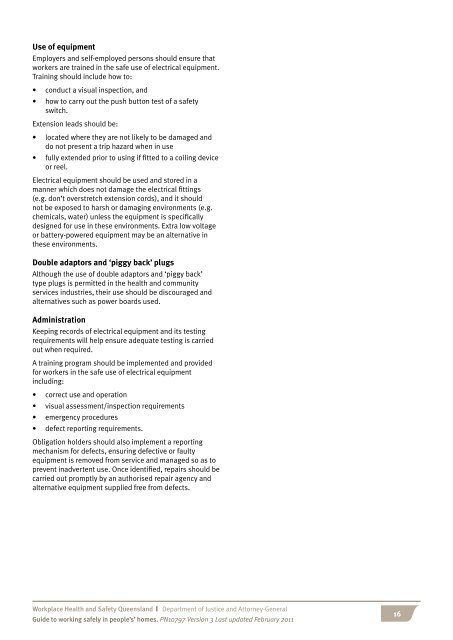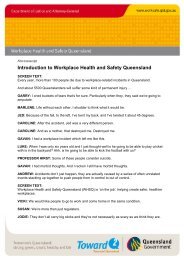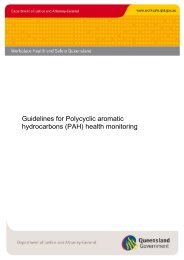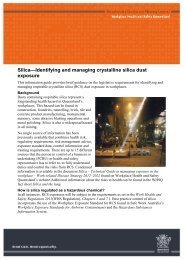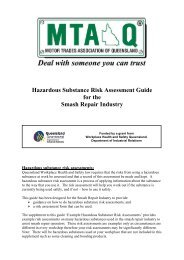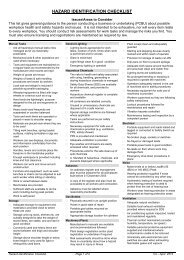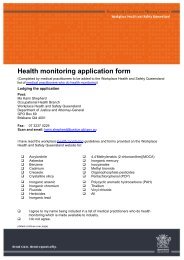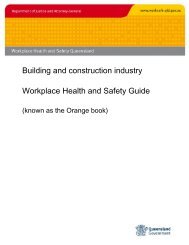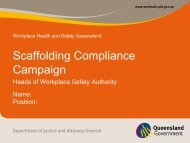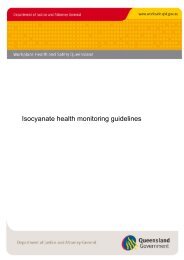Guide to working safely in people's homes - Queensland Government
Guide to working safely in people's homes - Queensland Government
Guide to working safely in people's homes - Queensland Government
Create successful ePaper yourself
Turn your PDF publications into a flip-book with our unique Google optimized e-Paper software.
Use of equipment<br />
Employers and self-employed persons should ensure that<br />
workers are tra<strong>in</strong>ed <strong>in</strong> the safe use of electrical equipment.<br />
Tra<strong>in</strong><strong>in</strong>g should <strong>in</strong>clude how <strong>to</strong>:<br />
• conduct a visual <strong>in</strong>spection, and<br />
• how <strong>to</strong> carry out the push but<strong>to</strong>n test of a safety<br />
switch.<br />
Extension leads should be:<br />
• located where they are not likely <strong>to</strong> be damaged and<br />
do not present a trip hazard when <strong>in</strong> use<br />
• fully extended prior <strong>to</strong> us<strong>in</strong>g if fitted <strong>to</strong> a coil<strong>in</strong>g device<br />
or reel.<br />
Electrical equipment should be used and s<strong>to</strong>red <strong>in</strong> a<br />
manner which does not damage the electrical fitt<strong>in</strong>gs<br />
(e.g. don’t overstretch extension cords), and it should<br />
not be exposed <strong>to</strong> harsh or damag<strong>in</strong>g environments (e.g.<br />
chemicals, water) unless the equipment is specifically<br />
designed for use <strong>in</strong> these environments. Extra low voltage<br />
or battery-powered equipment may be an alternative <strong>in</strong><br />
these environments.<br />
Double adap<strong>to</strong>rs and ‘piggy back’ plugs<br />
Although the use of double adap<strong>to</strong>rs and ‘piggy back’<br />
type plugs is permitted <strong>in</strong> the health and community<br />
services <strong>in</strong>dustries, their use should be discouraged and<br />
alternatives such as power boards used.<br />
Adm<strong>in</strong>istration<br />
Keep<strong>in</strong>g records of electrical equipment and its test<strong>in</strong>g<br />
requirements will help ensure adequate test<strong>in</strong>g is carried<br />
out when required.<br />
A tra<strong>in</strong><strong>in</strong>g program should be implemented and provided<br />
for workers <strong>in</strong> the safe use of electrical equipment<br />
<strong>in</strong>clud<strong>in</strong>g:<br />
• correct use and operation<br />
• visual assessment/<strong>in</strong>spection requirements<br />
• emergency procedures<br />
• defect report<strong>in</strong>g requirements.<br />
Obligation holders should also implement a report<strong>in</strong>g<br />
mechanism for defects, ensur<strong>in</strong>g defective or faulty<br />
equipment is removed from service and managed so as <strong>to</strong><br />
prevent <strong>in</strong>advertent use. Once identified, repairs should be<br />
carried out promptly by an authorised repair agency and<br />
alternative equipment supplied free from defects.<br />
Workplace Health and Safety <strong>Queensland</strong> | Department of Justice and At<strong>to</strong>rney-General<br />
<strong>Guide</strong> <strong>to</strong> <strong>work<strong>in</strong>g</strong> <strong>safely</strong> <strong>in</strong> people’s’ <strong>homes</strong>. PN10797 Version 3 Last updated February 2011<br />
16


